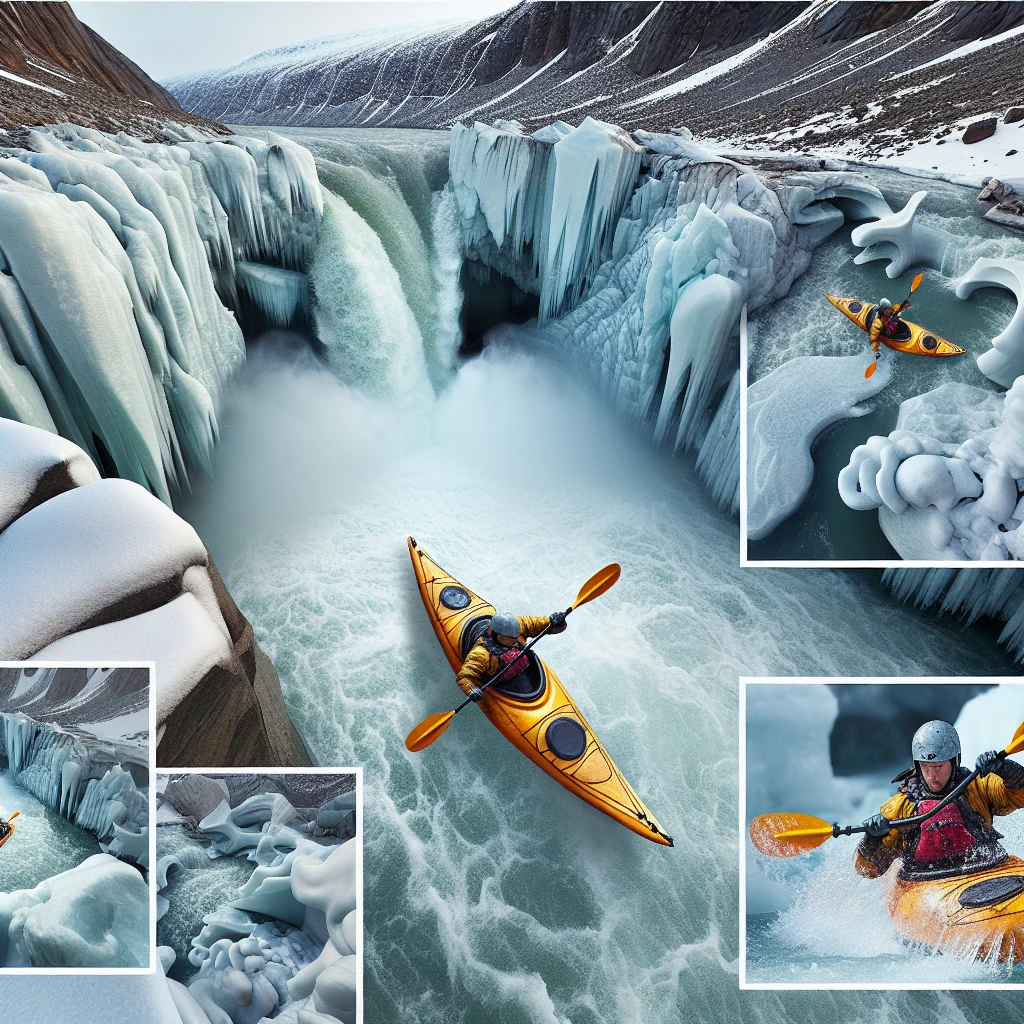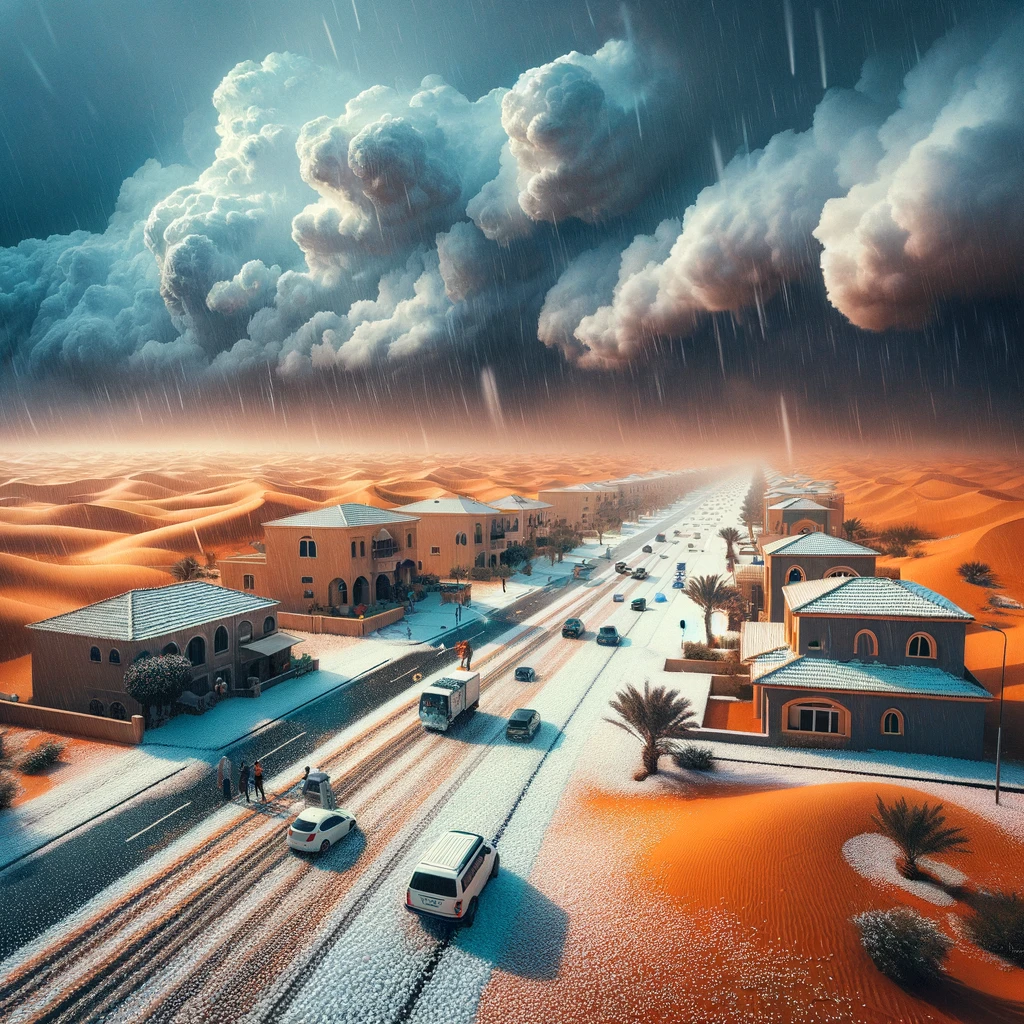A 32-year-old man from Catalonia has achieved a remarkable feat by descending down a 20-meter glacial waterfall in Svalbard, Norway. This is the largest recorded descent of its kind. Aniol Serrasolses navigated through the rapids and ice tunnels of the glacial river before taking on the ice waterfall. He described the experience as being like kayaking on another planet.
The video footage of Serrasolses’ breathtaking descent showcases the beauty and danger of this extreme sport. The kayaker’s skill and bravery are evident as he maneuvers through the icy terrain. This achievement is a testament to the human spirit of adventure and the desire to push the limits of what is possible.
Svalbard, located in the Arctic Circle, is known for its stunning landscapes and icy wilderness. The glacial waterfalls in this region are particularly challenging and require expert navigation skills. Serrasolses’ accomplishment not only showcases his personal achievement but also highlights the natural wonders of this remote part of the world.
This video serves as an inspiration for other kayakers and adventure enthusiasts who are looking to push their boundaries and explore new frontiers. It demonstrates the importance of skill, preparation, and respect for nature when engaging in extreme sports. Serrasolses’ achievement will undoubtedly go down in history as a remarkable feat in the world of kayaking.
Overall, this video captures the awe-inspiring beauty and excitement of extreme sports, while also highlighting the importance of skill and respect for nature. It serves as a reminder that there are still unexplored frontiers waiting to be conquered, and that with determination and courage, anything is possible.
Original news source: Kayaker’s 20m drop down ice waterfall in Svalbard, Norway (BBC)
Listen
Slow
Normal
Fast
Group or Classroom Activities
Warm-up Activities:
– News Summary
Instructions: In pairs or small groups, students will read the article and then summarize the main points in their own words. They can take turns sharing their summaries with the class.
– Opinion Poll
Instructions: Students will form pairs or small groups and discuss their opinions on extreme sports and pushing personal boundaries. They will then create a poll with questions related to the topic and survey their classmates. After gathering the data, they will present their findings to the class.
– Vocabulary Pictionary
Instructions: Divide the class into two teams. Provide each team with a list of vocabulary words from the article. One student from each team will come to the front of the class and have one minute to draw and have their team guess as many words as possible. The team with the most correct guesses wins.
– Headline Creation
Instructions: In pairs or small groups, students will create catchy headlines for the article. They should aim to capture the excitement and significance of the kayaker’s achievement. After brainstorming, each group will share their best headline with the class.
– Future Predictions
Instructions: Students will individually write a short paragraph predicting what extreme sports and adventure activities will be like in the future. They should consider advancements in technology, changes in the environment, and any other factors that could impact the world of extreme sports. After writing, students can share their predictions in small groups or with the whole class.
Comprehension Questions:
1. How did Aniol Serrasolses describe the experience of descending down the glacial waterfall?
2. What is the significance of Serrasolses’ descent in the world of kayaking?
3. Where is Svalbard located and what is it known for?
4. What skills are required to navigate the glacial waterfalls in Svalbard?
5. What does the video footage of Serrasolses’ descent showcase?
6. How does this achievement highlight the natural wonders of Svalbard?
7. Who is the intended audience for this video?
8. What does this video serve as a reminder of?
Go to answers ⇩
Listen and Fill in the Gaps:
A 32-year-old man from (1)______ has achieved a (2)______ feat by descending down a 20-meter glacial waterfall in (3)______, Norway. This is the largest (4)______ descent of its kind. Aniol Serrasolses navigated through the rapids and ice tunnels of the glacial river before taking on the ice waterfall. He described the experience as being like kayaking on another planet.
The video footage of Serrasolses’ breathtaking descent showcases the beauty and danger of this extreme sport. The kayaker’s skill and bravery are evident as he (5)______ through the icy terrain. This achievement is a (6)______ to the human spirit of (7)______ and the desire to push the limits of what is possible.
Svalbard, located in the Arctic Circle, is known for its stunning landscapes and icy wilderness. The glacial waterfalls in this region are particularly (8)______ and require expert navigation skills. Serrasolses’ accomplishment not only (9)______ his personal achievement but also highlights the (10)______ wonders of this remote part of the world.
This (11)______ serves as an inspiration for other kayakers and adventure (12)______ who are looking to push their boundaries and explore new frontiers. It demonstrates the importance of skill, preparation, and respect for nature when engaging in extreme sports. Serrasolses’ achievement will undoubtedly go down in history as a remarkable feat in the world of kayaking.
Overall, this video captures the awe-inspiring beauty and excitement of extreme sports, while also highlighting the importance of (13)______ and (14)______ for (15)______. It serves as a (16)______ that there are still unexplored frontiers waiting to be conquered, and that with determination and courage, anything is possible.
Go to answers ⇩
Discussion Questions:
Students can ask a partner these questions, or discuss them as a group.
1. What is your opinion on extreme sports like kayaking down glacial waterfalls?
2. Have you ever participated in an extreme sport? If so, what was your experience like?
3. How would you feel if you were in Aniol Serrasolses’ position, descending down a 20-meter glacial waterfall?
4. Do you think extreme sports like kayaking down glacial waterfalls are worth the risks involved? Why or why not?
5. What other extreme sports do you find interesting or exciting? Why?
6. Have you ever visited a remote or wilderness area? If so, what was your experience like?
7. Do you think extreme sports can have a positive impact on the environment? Why or why not?
8. How important do you think skill and preparation are when engaging in extreme sports?
9. What do you think motivates people to participate in extreme sports?
10. How do you think extreme sports can push the limits of what is possible for humans?
11. Have you ever been inspired by someone’s achievements in a particular sport or activity? If so, who and why?
12. Do you think extreme sports are becoming more or less popular? Why?
13. What are some potential dangers or risks associated with extreme sports?
14. How do you think extreme sports can impact a person’s mental and physical well-being?
15. Have you ever felt the desire to push your own boundaries and explore new frontiers? If so, how did you satisfy that desire?
Individual Activities
Vocabulary Meanings:
Match each word to its meaning.
Words:
1. descent
2. glacial
3. rapids
4. ice
5. kayaking
6. achievement
7. wilderness
8. boundaries
Meanings:
(a) The sport of using a small boat to navigate water
(b) The act of moving downward or falling
(c) Relating to a large mass of ice
(d) An uncultivated, uninhabited area
(e) Limits or borders
(f) Fast-moving, turbulent areas of a river
(g) Frozen water
(h) Something accomplished successfully
Go to answers ⇩
Multiple Choice Questions:
1. Where did the man descend down a glacial waterfall?
(a) Svalbard, Norway
(b) Catalonia, Spain
(c) Arctic Circle
(d) Berlin, Germany
2. How tall was the glacial waterfall?
(a) 20 meters
(b) 10 meters
(c) 30 meters
(d) 40 meters
3. What did the man describe the experience as?
(a) Like kayaking in a river
(b) Like kayaking in a lake
(c) Like kayaking on another planet
(d) Like kayaking in the ocean
4. What does the video footage showcase?
(a) The beauty of the Arctic Circle
(b) The beauty of Svalbard
(c) The beauty of Norway
(d) The beauty and danger of the extreme sport
5. Where is Svalbard located?
(a) Catalonia
(b) Norway
(c) Berlin
(d) Arctic Circle
6. What does Serrasolses’ achievement highlight?
(a) The natural wonders of Catalonia
(b) The natural wonders of Svalbard
(c) The natural wonders of Norway
(d) The natural wonders of the Arctic Circle
7. Who is this video an inspiration for?
(a) Skiers and snowboarders
(b) Hikers and climbers
(c) Kayakers and adventure enthusiasts
(d) Cyclists and runners
8. What does this video serve as a reminder of?
(a) The importance of skill and respect for nature
(b) Unexplored frontiers waiting to be conquered
(c) The beauty and excitement of extreme sports
(d) The determination and courage of athletes
Go to answers ⇩
True or False Questions:
1. The glacial waterfalls in Svalbard are not particularly challenging and do not require expert navigation skills.
2. This descent is not the largest recorded of its kind.
3. Svalbard is not known for its stunning landscapes and icy wilderness.
4. A 32-year-old man from Catalonia achieved a record-breaking descent down a 20-meter glacial waterfall in Svalbard, Norway.
5. The video footage showcases the beauty and danger of extreme kayaking.
6. The kayaker avoided rapids and ice tunnels before taking on the ice waterfall.
7. The kayaker described the experience as being like kayaking on another planet.
8. This achievement serves as an inspiration for other kayakers and adventure enthusiasts.
Go to answers ⇩
Write a Summary:
Write a summary of this news article in two sentences.
Check your writing now with the best free AI for English writing!
Writing Questions:
Answer the following questions. Write as much as you can for each answer.
Check your answers with our free English writing assistant!
1. Where did Aniol Serrasolses achieve his remarkable feat of descending down a 20-meter glacial waterfall?
2. How did Serrasolses describe the experience of kayaking down the ice waterfall?
3. What does the video footage of Serrasolses’ descent showcase?
4. What skills are required to navigate the challenging glacial waterfalls in Svalbard?
5. What is the significance of Serrasolses’ achievement in the world of kayaking?
Answers
Comprehension Question Answers:
1. How did Aniol Serrasolses describe the experience of descending down the glacial waterfall?
He described the experience as being like kayaking on another planet.
2. What is the significance of Serrasolses’ descent in the world of kayaking?
It is the largest recorded descent of its kind and showcases the skill and bravery of the kayaker.
3. Where is Svalbard located and what is it known for?
Svalbard is located in the Arctic Circle and is known for its stunning landscapes and icy wilderness.
4. What skills are required to navigate the glacial waterfalls in Svalbard?
Expert navigation skills are required to navigate the glacial waterfalls in Svalbard.
5. What does the video footage of Serrasolses’ descent showcase?
The video footage showcases the beauty and danger of the extreme sport and highlights Serrasolses’ skill and bravery.
6. How does this achievement highlight the natural wonders of Svalbard?
It showcases the challenging and stunning landscapes of Svalbard, particularly the glacial waterfalls.
7. Who is the intended audience for this video?
The intended audience for this video is kayakers and adventure enthusiasts.
8. What does this video serve as a reminder of?
It serves as a reminder that there are still unexplored frontiers waiting to be conquered and that with determination and courage, anything is possible.
Go back to questions ⇧
Listen and Fill in the Gaps Answers:
(1) Catalonia
(2) remarkable
(3) Svalbard
(4) recorded
(5) maneuvers
(6) testament
(7) adventure
(8) challenging
(9) showcases
(10) natural
(11) video
(12) enthusiasts
(13) skill
(14) respect
(15) nature
(16) reminder
Go back to questions ⇧
Vocabulary Meanings Answers:
1. descent
Answer: (b) The act of moving downward or falling
2. glacial
Answer: (c) Relating to a large mass of ice
3. rapids
Answer: (f) Fast-moving, turbulent areas of a river
4. ice
Answer: (g) Frozen water
5. kayaking
Answer: (a) The sport of using a small boat to navigate water
6. achievement
Answer: (h) Something accomplished successfully
7. wilderness
Answer: (d) An uncultivated, uninhabited area
8. boundaries
Answer: (e) Limits or borders
Go back to questions ⇧
Multiple Choice Answers:
1. Where did the man descend down a glacial waterfall?
Answer: (a) Svalbard, Norway
2. How tall was the glacial waterfall?
Answer: (a) 20 meters
3. What did the man describe the experience as?
Answer: (c) Like kayaking on another planet
4. What does the video footage showcase?
Answer: (d) The beauty and danger of the extreme sport
5. Where is Svalbard located?
Answer: (d) Arctic Circle
6. What does Serrasolses’ achievement highlight?
Answer: (b) The natural wonders of Svalbard
7. Who is this video an inspiration for?
Answer: (c) Kayakers and adventure enthusiasts
8. What does this video serve as a reminder of?
Answer: (b) Unexplored frontiers waiting to be conquered
Go back to questions ⇧
True or False Answers:
1. The glacial waterfalls in Svalbard are not particularly challenging and do not require expert navigation skills. (Answer: False)
2. This descent is not the largest recorded of its kind. (Answer: False)
3. Svalbard is not known for its stunning landscapes and icy wilderness. (Answer: False)
4. A 32-year-old man from Catalonia achieved a record-breaking descent down a 20-meter glacial waterfall in Svalbard, Norway. (Answer: True)
5. The video footage showcases the beauty and danger of extreme kayaking. (Answer: True)
6. The kayaker avoided rapids and ice tunnels before taking on the ice waterfall. (Answer: False)
7. The kayaker described the experience as being like kayaking on another planet. (Answer: True)
8. This achievement serves as an inspiration for other kayakers and adventure enthusiasts. (Answer: True)
Go back to questions ⇧













